
Transkei, officially the Republic of Transkei, was an unrecognised state in the southeastern region of South Africa from 1976 to 1994. It was, along with Ciskei, a Bantustan for the Xhosa people, and operated as a nominally independent parliamentary democracy. Its capital was Umtata.

Traditional healers of Southern Africa are practitioners of traditional African medicine in Southern Africa. They fulfill different social and political roles in the community like divination, healing physical, emotional, and spiritual illnesses directing birth or death rituals, finding lost cattle, protecting warriors, counteracting witchcraft and narrating the history, cosmology, and concepts of their tradition.

Ciskei, officially the Republic of Ciskei, was a Bantustan for the Xhosa people, located in the southeast of South Africa. It covered an area of 7,700 square kilometres (3,000 sq mi), almost entirely surrounded by what was then the Cape Province, and possessed a small coastline along the shore of the Indian Ocean.

Zenzile Miriam Makeba, nicknamed Mama Africa, was a South African singer, songwriter, actress, and civil rights activist. Associated with musical genres including Afropop, jazz, and world music, she was an advocate against apartheid and white-minority government in South Africa.
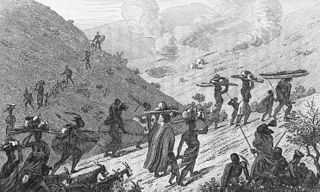
The amaMfengu was a reference of Xhosa clans whose ancestors were refugees that fled from the Mfecane in the early-mid 19th century to seek land and protection from the Xhosa. These refugees were assimilated into the Xhosa nation and were officially recognized by the then king, Hintsa. The term derives from the Xhosa verb "ukumfenguza" which means to wander about seeking service.

Qonce, or King William's Town, is a town in the Eastern Cape province of South Africa along the banks of the Buffalo River. The town is about 60 kilometres (37 mi) northwest of the Indian Ocean port of East London. It has a population of around 35,000 inhabitants and forms part of the Buffalo City Metropolitan Municipality.
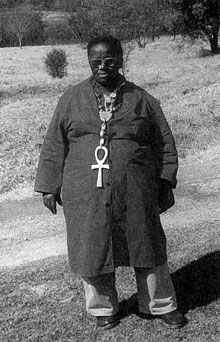
Vusamazulu Credo Mutwa was a Zulu sangoma from South Africa. He was known as an author of books that draw upon African mythology, traditional Zulu folklore, extraterrestrial encounters and his own personal encounters. His last work was a graphic novel called the Tree of Life Trilogy based on his writings of his most famous book, Indaba my Children. In 2018 he was honoured with an USIBA award presented by the South African Department of Arts and Culture, for his work in Indigenous Wisdom.

Langa is a township in Cape Town, South Africa. Its name in Xhosa means "sun". The township was initially built in phases before being formally opened in 1927. It was developed as a result of South Africa's 1923 Urban Areas Act, which was designed to force Africans to move from their homes into segregated locations. Similar to Nyanga, Langa is one of the many areas in South Africa that were designated for Black Africans before the apartheid era. It is the oldest of such suburbs in Cape Town and was the location of much resistance to apartheid.
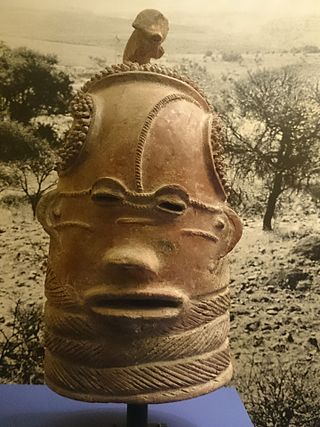
South African Bantu-speaking peoples represent the majority ethno-racial group of South Africans. Occasionally grouped as Bantu, the term itself is derived from the English word "people", common to many of the Bantu languages. The Oxford Dictionary of South African English describes "Bantu", when used in a contemporary usage or racial context as "obsolescent and offensive", because of its strong association with the "white minority rule" with their Apartheid system. However, Bantu is used without pejorative connotations in other parts of Africa and is still used in South Africa as the group term for the language family.
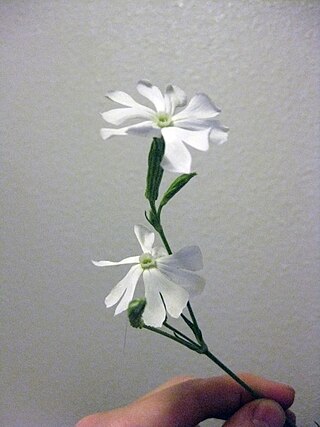
Silene undulata is a plant native to the Eastern Cape of South Africa.

South Africa, officially the Republic of South Africa, is the southernmost country in Africa. It is bounded to the south by 2,798 kilometres (1,739 mi) of coastline that stretches along the South Atlantic and Indian Oceans; to the north by the neighbouring countries of Namibia, Botswana, and Zimbabwe; and to the east and northeast by Mozambique and Eswatini. It also completely enclaves the country Lesotho. It is the southernmost country on the mainland of the Old World, and the second-most populous country located entirely south of the equator, after Tanzania. South Africa is a biodiversity hotspot, with unique biomes, plant and animal life. With over 62 million people, the country is the world's 23rd-most populous nation and covers an area of 1,221,037 square kilometres. Pretoria is the administrative capital, while Cape Town, as the seat of Parliament, is the legislative capital. Bloemfontein has traditionally been regarded as the judicial capital. The largest city, and site of highest court is Johannesburg.

The Xhosa people, or Xhosa-speaking people are a Bantu ethnic group whose traditional homeland is primarily the Eastern Cape Province of South Africa. They received the name Xhosa from the Khoi, meaning the violent angry people. [[Southern Africa] IsiXhosa language.

Makhanda, also spelled Makana and also known as Nxele, was a Xhosa indigenous doctor. He served as a top advisor to Chief Ndlambe. During the Xhosa Wars, on the 22nd of April, 1819, he initiated an abortive assault on the town of Grahamstown, in what was then the Cape Colony.
Mercy Manci is a Xhosa sangoma and HIV denialist from South Africa. She has participated and presented at conferences in a.o. Cameroon, Nigeria, and Italy.

The Cape Qualified Franchise was the system of non-racial franchise that was adhered to in the Cape Colony, and in the Cape Province in the early years of the Union of South Africa. Qualifications for the right to vote at parliamentary elections were applied equally to all men, regardless of race.
Warwick Junction, also known as Warwick Triangle, is a transportation and trading hub in the city of Durban, South Africa. It is the largest of its kind in South Africa. The area sees up to 460 000 people daily, who come to the area to for its transport interchange and market shopping.
Hacjivah Graham Dayimani is a South African rugby union player for the Stormers in the United Rugby Championship and the Western Province in the Currie Cup. His regular position is number eight or flanker.
Nkunzi Zandile Nkabinde was a South African sangoma, author, and LGBT activist. They are recognized for their work and writings surrounding LGBT life as a South African, and they are best known for their memoir Black Bull, Ancestors and Me: My Life as a Lesbian Sangoma.

Jonathan Ancer is a South African journalist, author, podcaster and media trainer. He wrote Uncovering Craig Williamson, which was on the longlist for the Alan Paton literary prize. Ancer wrote Betrayal: The Secret Lives of Apartheid Spies which was released in 2019.
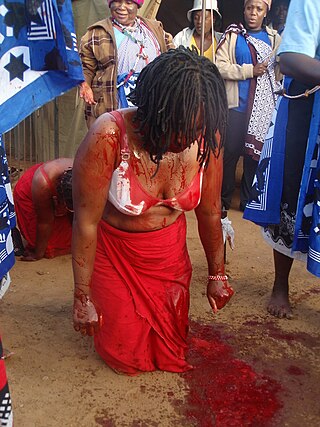
Ukuthwasa is a Southern African culture-bound syndrome associated with the calling and the initiation process to become a sangoma, a type of traditional healer. In the cultural context of traditional healers in Southern Africa, the journey of ukuthwasa involves a deeply spiritual process marked by rituals, teachings, and preparations. It begins with a calling, idlozi, from ancestors, often received through dreams or altered states of consciousness. Ukuthwasa process entails physical, psychological, and spiritual manifestations, which are believed to cleanse and prepare the initiate. The term ukuthwasa meaning "come out" or "be reborn," signifies the transformative nature of the experience. Both men and women can become traditional healers through this calling.
















